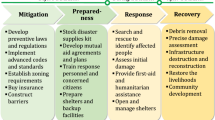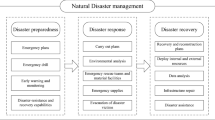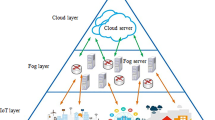Abstract
Disaster monitoring and prediction is one of the most important stages in disaster management. Critical crowdsourced Internet of Things data collected from various geographic resources (such as sensors, mobile devices, vehicles, humans, etc.) are evaluated and analyzed to effectively predict natural disasters. Cloud computing is a widely used technology for analyzing crowdsourced data in specific geographic areas. However, the time it takes to analyze these data can be long, huge end-end delay, and Quality of Service degradation. It also increases the loss of a large number of people during the disaster. Hence, fog computing is used to analyze these critical crowd sourced data, that is, for latency sensitive applications. This paper uses an efficient FBC algorithm in the fog computing platform, and proposes a fog-based disaster monitoring framework. The terminal device at the end user layer does not perform any processing or FBC clustering on the data. On the contrary, the fog node in the fog layer and the cloud server in the cloud computing layer perform FBC clustering, which helps to predict disasters in time. The proposed scheme is evaluated in terms of latency, response time and bandwidth, and the proposed scheme performs better than the centralized and distributed schemes.











Similar content being viewed by others
References
5WSmodel. Five ws model, https://en.wikipedia.org/wiki/Five-Ws, 2017. [Online; Accessed on 10-March-2019]
Aboubi Yasmine, Drias Habiba, Kamel Nadjet (2016) Bat-clara: Bat-inspired algorithm for clustering large applications. IFAC-PapersOnLine 49(12):243–248
Al-Sultan Khaled S, Selim Shokri Z (1993) A global algorithm for the fuzzy clustering problem. Patt Recog 26(9):1357–1361
Behera HS, Nayak J, Nanda M, Nayak K (2015) A novel hybrid approach for real world data clustering algorithm based on fuzzy c-means and firefly algorithm. Int J Fuzzy Comput Modell 1(4):431–448
Berawi MA, Onggar Siahaan SA, Miraj P, Leviakangas P et al (2020) Determining the prioritized victim of earthquake disaster using fuzzy logic and decision tree approach. Evergreen 7(2):246–252
BoussaïD Ilhem, Lepagnot Julien, Siarry Patrick (2013) A survey on optimization metaheuristics. Inf Sci 237:82–117
Buckles BP, Petry FE, Prabhu D, George R, and Srikanth R (1994) Fuzzy clustering with genetic search. In Evolutionary Computation, 1994. IEEE World Congress on Computational Intelligence., Proceedings of the First IEEE Conference on, 46–50. IEEE
Facebook. Facebook safety check, https://en.wikipedia.org/wiki/Facebook-Safety-Check, 2017. [Online; Accessed on 10-March-2019]
Giezeman W (2016). Building a crowdsourced global iot network operator. IoT Newsletter
Handmer J, Choy S, Kohtake N (2014) Updating warning systems for climate hazards. Aust J Telecommun Digital Econ 1:2(4)
Han S, Huang H, Luo Z, and Foropon C (2018). Harnessing the power of crowdsourcing and internet of things in disaster response. Ann Operat Res, 1–16
Harrison SE, Johnson PA (2016) Crowdsourcing the disaster management cycle. Int J Inform Syst Crisis Resp Manag (IJISCRAM) 8(4):17–40
He Y, Wan J (2020) Flood hazard assessment based on fuzzy clustering iterative model and chaotic particle swarm optimization. J Ambient Intell Humaniz Comput 1:1–10
Jung D, Tuan VuT, Tran QD, Park M, Park S et al (2020) Conceptual framework of an intelligent decision support system for smart city disaster management. Appl Sci 10(2):666
Karaboga Dervis, Basturk Bahriye (2007) A powerful and efficient algorithm for numerical function optimization: artificial bee colony (abc) algorithm. J Global Optim 39(3):459–471
Kucuk K, Bayilmis C, Sonmez AE, Kacar S (2019) Crowd sensing aware disaster framework design with iot technologies. J Ambient Intell Humaniz Comput 1:1–17
Lin Wei-Yu, Tzong-Hann Wu, Tsai Meng-Han, Hsu Wei-Che, Chou Yu-Te, Kang Shih-Chung (2018) Filtering disaster responses using crowdsourcing. Autom Constr 91:182–192
Mejri Ouejdane, Menoni Scira, Matias Kyla, Aminoltaheri Negar (2017) Crisis information to support spatial planning in post disaster recovery. Int J Disas Risk Reduction 22:46–61
oceanicdataset. National oceanic and atmospheric administration dataset, https://www.noaa.gov/climate_data_and_reports, 2017. [Online; Accessed on 20-February-2019]
Onyango MA and Uwase M (2017). Humanitarian response to complex emergencies and natural disasters
Petersen H, Baccelli E, Matthias Wählisch, Schmidt TC, and Schiller J (2014). The role of the internet of things in network resilience. In international internet of things summit, pages 283–296. Springer
Puthal D, Nepal S, Ranjan R, and Chen J (2016). A secure big data stream analytics framework for disaster management on the cloud. In 2016 IEEE 18th international conference on high performance computing and communications; IEEE 14th international conference on smart city; IEEE 2nd international conference on data science and systems (HPCC/SmartCity/DSS), 1218–1225. IEEE, 2016
Rauniyar A, Engelstad P, Feng B, et al. (2016) Crowdsourcing-based disaster management using fog computing in internet of things paradigm. In 2016 IEEE 2nd international conference on collaboration and internet computing (CIC), 490–494. IEEE
Sree TR and Bhanu SMS (2019). Detection of http flooding attacks in cloud using fuzzy bat clustering. Neural Comput Appl, 1–17
Ujjwal KC, Garg S, Hilton J, Aryal J, and Forbes-Smith N (2019). Cloud computing in natural hazard modeling systems: current research trends and future directions. Int J Disas Risk Red, 101188
Wang L, Liu Y, Zhao X, and Xu Y (2006). Particle swarm optimization for fuzzy c-means clustering. In Intelligent Control and Automation, 2006. WCICA 2006. The Sixth World Congress on, 2: 6055–6058. IEEE, 2006
William CC (2016) Disaster management, crowdsourced r&d and probabilistic innovation theory: toward real time disaster response capability. Int J Disast Risk Reduction 17:238–250
Wu Q (2020) Applications and theoretical challenges in environmental emergency issues alerting system on iot intelligence. Comput Commun
Yang X-S (2010). A new metaheuristic bat-inspired algorithm. Nat Inspired Cooperat strateg Optimiz (NICSO 2010), 65–74
Funding
There is no funding for this research article.
Author information
Authors and Affiliations
Corresponding author
Ethics declarations
Conflict of interest
The author declare that they have no conflict of interest.
Additional information
Publisher's Note
Springer Nature remains neutral with regard to jurisdictional claims in published maps and institutional affiliations.
Rights and permissions
About this article
Cite this article
Sree, T.R. A Framework for disaster management using fuzzy bat clustering in fog computing. Int J Syst Assur Eng Manag 13, 1623–1636 (2022). https://doi.org/10.1007/s13198-021-01518-9
Received:
Revised:
Accepted:
Published:
Issue Date:
DOI: https://doi.org/10.1007/s13198-021-01518-9




